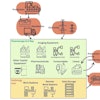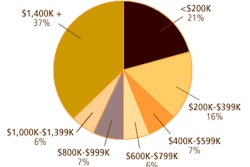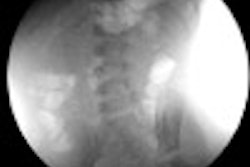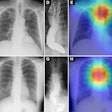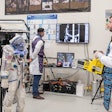Interventionalists who perform endograft procedures to correct abdominal aortic aneurysms (AAA) can't afford to "scrimp" on their understanding of imaging if they are going to choose the right modality for their patients, according to a presentation last week at the International Symposium on Endovascular Technology (ISET) meeting in Hollywood, FL.
"Every patient is different, and you can't assume you can use the same (imaging) devices on one patient as you do on another," said Dr. Roy Greenberg, who is the director of endovascular research in the department of vascular and cardiothoracic surgery at the Cleveland Clinic in Ohio.
"Physicians performing abdominal aortic aneurysm repair must understand imaging," he added.
Imaging's most important role in AAA endograft repair is determining the centerline of flow through the aorta so that the endograft is positioned properly for optimal blood flow. During endograft placement, Greenberg recommended portable fluoroscopy, CT (single plane or biplane), and/or CT angiography (CTA). For post-treatment follow-up, he advised CT, ultrasonography, or x-ray.
Greenberg also warned ISET attendees to use contrast materials with caution, especially in some AAA patients for whom iodine-based contrast may be contraindicated. Interventionalists will soon be able to use dual-source CTA to distinguish between blood and bone, and future imaging technology will allow for the creation of automated branch graft formulas, as well as the ability to detail the blood vessel system, he said.
Fertility and UFE
In a second ISET talk, the presenters asserted that uterine fibroid embolization (UFE) carried the risk of impeding future fertility, so careful management of patients was necessary.
"We have a great bulk of literature that proves the safety of this procedure," said Dr. Howard Chrisman, an associate professor of radiology at the Northwestern University School of Medicine in Chicago. He cited Fibroid Registry for Outcomes Data (FIBROID) figures that put the major adverse effects of embolization at less than 1% of patients.
However, other studies have indicated that 2% to 15% of women who underwent UFE experienced amenorrhea and, ultimately, the inability to conceive, Chrisman noted.
"Exactly why fibroids impact fertility is not known," he said. "In about 1% to 2.5% of the women with fertility problems, fibroids may be the sole reason." Fibroids may occupy too much space in the uterus to allow for fetal development, affecting contractibility and implantation, he added.
Women of childbearing age who plan to have children should be advised by their gynecologist of other fibroid treatment options, Chrisman advised the ISET audience. Women who have completed childbearing or are postmenopausal would be the most appropriate candidates for UFE.
In another UFE study presented at the ISET meeting, Dr. Matt Mauro, a professor of radiology and surgery at the University of North Carolina at Chapel Hill, reviewed one-year outcomes from a registry of more than 3,000 women who have undergone UFE. The rate of major in-hospital adverse events was 0.66% or 20 adverse events in 18 women out of 3,000.
In the 30 days after hospital discharge, 111 women reported 135 incidents -- about 4.1% of the women in the trial -- with recurrent pain occurring in 65 of those incidents, Mauro said.
"No deaths were reported in this registry," Mauro said. "There was a striking, marked improvement in both symptom scores and quality of life scores. Patient satisfaction was high and most patients believed their treatment was a success and would recommend it to other women."
By Edward Susman
AuntMinnie.com contributing writer
February 12, 2007
Related Reading
Endograft placement safer than open chest surgery for torn aorta, January 31, 2007
Uterine artery embolization for fibroids speeds recovery, January 25, 2007
Tumor regrowth generally calls for second UAE procedure, January 23, 2007
Endovascular repair of acute abdominal aortic aneurysm less costly than surgery, September 4, 2006
CT angiography trumps DSA in renal artery stenosis, says ISET speaker, January 26, 2006
Copyright © 2007 AuntMinnie.com



